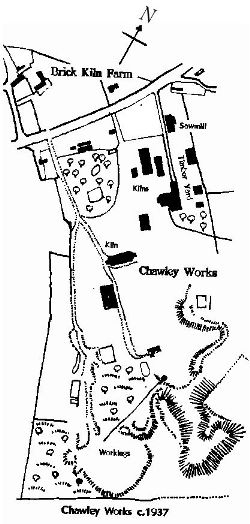Geologist and science writer Nina Morgan celebrates the lasting legacy of a former brickpit
Geoscientist 22.07 August 2012

The Chawley Brick and Tile Works – now ironically hidden behind the bricks and mortar of a new housing estate on Cumnor Hill near Oxford – played an important role in the local economy for nearly 100 years. At Chawley the Jurassic Corallian limestone is overlain by around 24m of Kimmeridge Clay topped by the Iron Sands of the Cretaceous Lower Greensand. So geologically speaking, the Chawley works were well suited for the production of bricks, tiles and lime, with raw materials possessing suitable properties available on-site. The Kimmeridge Clay formed a particularly useful ‘source rock’ for brick-making because it is easy to dig and contains around 8% of bituminous material which burns during firing, thus helping to reduce fuel costs.
The brickworks were established in about 1846 by a local farmer, John Neale. The business prospered, and in one year a record five million bricks were made. However during the 1930s the combination of a disastrous fire and increasing competition from larger companies, such as London Brick weakened the business. By 1937 the company was bankrupt and work at Chawley ceased. Its closing also effectively marked the end of the use of Kimmeridge Clay for brickmaking in Britain.
But while the Chawley Brick and Tile works may be long gone, they are certainly not forgotten. Orange-coloured Chawley bricks along with red or bluish Chawley ‘treacle tiles’ – so-called because treacle was burned in the kilnsto produce a reducing atmosphere – can still be seen in 19th Century houses in the area. And an iguanodontid (now designated as the type specimen of Camptosaurus prestwichii) discovered by quarrymen and afterwards collected by Joseph Prestwich, then Professor of Geology at Oxford,is now on display at the Oxford University Museum of Natural History. Many other important fossils, including bones of plesiosaurs, pliosaurs, dacosaurs and ichthyosaurs, were also recovered, along with a great number of ammonites and other invertebrates.
Although the hand digging of clay using grafts was, palaeontologically and stratigraphically speaking, potentially very interesting work – it wasn’t well paid. So workmen at the pit had to come up with other ways to supplement their meagre wages. The sale of fossils to visiting parties of geology students was one useful source of income, as was the selling of flower pots made from spare clay. But, in terms of modern communications, perhaps more the significant (if not the most lucrative) sidelines were the clay whistles in the shape of birds the workmen fashioned and sold. These ‘tweets’ predated the introduction of Twitter by a good 70+ years!
Acknowledgement
Sources for this vignette include an article about the Chawley Brick Pits written by Philip Powell which appeared in the May 2012 issue of the Cumnor Parish News;
The Chawley Brick and Tile Works, Cumnor, by I.C. Dodsworth in
Oxoniensia, vol. 41, 1976, pp. 348-353 (available at:
oxoniensia.org.volumes/1976/dodsworth.pdf);
Chawley Brick and Tile works, by Iris Wastie (available at:
www.bodley.ox.ac.uk/external/cumnor/articles/chawley-works.htm ); and
The Geology of Oxford by W.J. Arkell.
- If the past is the key to your present interests, why not join the History of Geology Group (HOGG)? For more information and to read the latest HOGG newsletter, visit: HOGG, where the programme and abstracts from the Conference on Geological Collectors and Collecting are available as a pdf file free to download.
*Nina Morgan is a geologist and science writer based near Oxford.